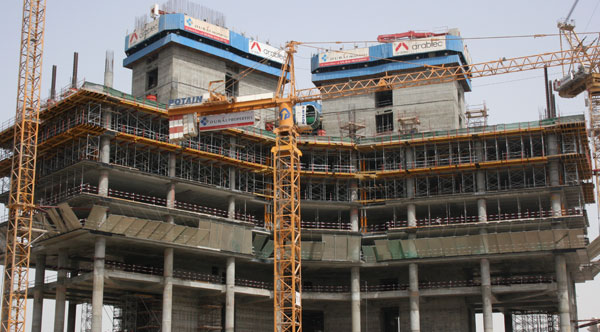Demand for concrete, steel set to double.
 Other News
Other News Subscribe to newsletter
Subscribe to newsletter
| 25 May 2008 |
Demand for ready mixed concrete, reinforcing steel and stone cladding is set to more than double next year as civil building construction projects peak across the Arabian Gulf but tail off in 2010, according to the latest market analysis.
"The phenomenal scale of building right now places the Gulf at the centre of the world's most concentrated construction boom," said Bernard Walsh, Managing Director of dmg world media Dubai, organisers of The Big 5, the region's largest trade show for the construction industry and associated suppliers taking place from 23-27 November 2008 at Dubai International Exhibition Centre.
Active civil building construction projects in the Gulf Co-operation Council countries are currently valued in excess of US$1.8 trillion, according to the database of research company Proleads which monitors major construction projects across the region from initial planning to completion.
The five biggest civil building projects in the GCC are in Saudi Arabia, the United Arab Emirates and Kuwait. Alone, they are budgeted at almost US$350 billion (see details below).
The projects in this latest analysis are all commercial, education, health, residential, retail, hotel, leisure, entertainment, theatre, cinema and mixed use buildings along with infrastructure such as canals, reclamation, airports, bridges, ports, roads and railways. They do not include industrial, oil and gas, power, water and other projects.
Concrete, reinforcing steel and claddings are fundamental elements in the civil construction industry and represent a massively important market for both manufacturers and suppliers in the Middle East.

For buildings alone, and based on standard industry ratios related to project values, the analysis forecasts demand for ready mixed concrete across the Gulf to reach US$8.6 billion at today's prices this year, more than double to US$18.7 billion next year before receding to US$15.5 billion in 2010.
Similarly in reinforcing steel, the forecast for this year is US$7.5 billion; US$16 billion in 2009 and down in 2010 to US$13.1 billion. Stone cladding, which marginally lags the concrete and reinforcing steel market, is expected to reach $1.5 billion this year, sharply rising to US$4.3 billion in 2009 and maintaining US$4.5 billion in 2010.
"These detailed forecasts for the basic building blocks of the construction industry are reflected in similar levels of increasing demand for all kinds of materials, fixtures and fittings used in the industry," said Walsh.
"The Big 5 is the most important five days for the construction industry in the Middle East and the platform for suppliers competing for multi-billion contracts in the region. Not only is it the largest for the industry in the Arabian Gulf but it also now one of the world’s largest trade shows for the construction industry."
The Big 5 is the most comprehensive event of the year for contractors, specifiers, architects, engineers and buyers throughout the GCC and neighbouring countries. In 2007, The Big 5 attracted 2,839 exhibitors, 30 government-sponsored pavilions and 50,420 professional trade buyers representing 139 countries.
The top five civil projects in the GCC by value:
1. King Abdullah Economic City: US$116 billion
Under construction for Emaar Economic City Company, this project involves a city at the Red Sea between Jeddah and Rabigh. It includes a seaport with 300,000 pilgrim capacity; an industrial district; a financial island; a resorts area; a residential zone to include 150,000 apartments; an educational zone with a campus for 18,000 students.
2. Silk City: US$86 billion
The centre of the planned city on Kuwait's Subiya peninsula will be a 1,001 metre high Mubarak Tower. The city will be made up of various zones including cultural, film, media, industrial, business, sports, and leisure, environment and health cities. There will also be a wildlife convention centre, exhibition centres, parks and housing for 700,000 people.
3. Dubailand-Bawadi Development: US$54 billion
This Tatweer project involves a tourist and leisure resort at the Dubailand development. It will include approximately 31 hotels with about 29,200 rooms of which 12,450 will be in Tatweer's 12 themed hotels. The development will offer 100 theatres, 1500 restaurants, entertainment and retail components. Asia-Asia, to be the world's largest hotel, will be the centrepiece providing 6,500 rooms.
4. Prince Abdulaziz Bin Mousaed Economic City: US$53 billion
Work has started on the US$53 billion development in Saudi Arabia with a logistics centre; an airport for 3.1 million passengers; a port for 1.5 million tons of cargo; a rail station for 3.2 million passengers; an agricultural centre; an entertainment zone for 700,000 tourists; a mining city; a petrochemical zone; an educational zone for 40,000 students; 3,000 commercial units and 30,000 residential units for 80,000 residents; infrastructure: power, water, drainage and 3,300 kilometres of roads.
5. Khalifa City: US$40 billion
The planned project is for a new UAE capital city located near Abu Dhabi. The project will comprise headquarters for all federal authorities, ministries, local government offices, embassies, residential units, offices and exhibition centres.




